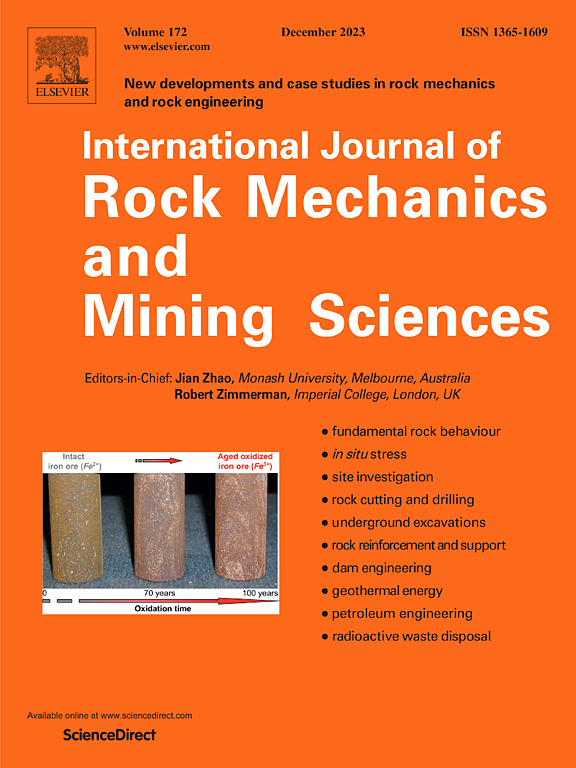水力机械耦合作用下风化花岗岩的破坏过程和渗透率演变的实验和数值研究
IF 7
1区 工程技术
Q1 ENGINEERING, GEOLOGICAL
International Journal of Rock Mechanics and Mining Sciences
Pub Date : 2025-04-15
DOI:10.1016/j.ijrmms.2025.106117
引用次数: 0
摘要
岩石破碎是海底隧道施工的基本过程,尤其是在深沟开挖过程中。了解水力机械耦合作用下岩体的破坏过程和渗透性演变对于优化开挖计划和确保施工安全至关重要。由于仅通过实验来捕捉裂缝扩展和渗透性演变的挑战,数值模拟提供了宝贵的补充。本研究采用三轴压缩试验和水力机械耦合条件下的 CFD-DEM 数值模拟,对深圳-中山大桥海底隧道深埋段的风化花岗岩进行了研究。实验结果表明,应力-应变曲线可分为五个不同的阶段,随着约束压力和流体压力的增加,塑性应变增量越来越集中,尤其是在强度峰值阶段之后。数值模拟进一步证明,较高的约束压力会促进剪切破坏,而较高的约束压力和流体压力则会加速稳定微裂缝的形成。接触力和渗流力主要集中在原生裂缝周围,接触力沿裂缝路径均匀分布,渗流力在渗流通道的入口和出口处最为明显。这些发现为了解岩石的内部水文机械行为提供了重要依据,有助于完善破岩策略,降低海底隧道建设项目的地质风险。本文章由计算机程序翻译,如有差异,请以英文原文为准。
Experimental and numerical investigations on failure process and permeability evolution of weathered granite under hydro-mechanical coupling
Rock-breaking is a fundamental process in subsea tunnel construction, particularly during deep trench excavation. Understanding the failure process and permeability evolution of rock masses under hydro-mechanical coupling is essential for optimizing excavation plans and ensuring construction safety. Due to the challenges of capturing crack propagation and permeability evolution solely through experiments, numerical simulations provide a valuable supplement. This study investigates the weathered granite from the deep section of the Shenzhen-Zhongshan Bridge subsea tunnel, employing triaxial compression tests and CFD-DEM numerical simulations under hydro-mechanical coupling conditions. The experimental results reveal that the stress-strain curves can be divided into five distinct stages, with plastic strain increments becoming more concentrated as confining pressure and fluid pressure increase, particularly after the peak strength stage. Numerical simulations further demonstrate that higher confining pressure promotes shear failure, while elevated confining and fluid pressures accelerate the formation of stable microcracks. Contact forces and seepage forces are predominantly concentrated around the primary cracks, with contact forces distributed uniformly along the crack path and seepage forces most pronounced at the inlets and outlets of the seepage channels. These findings offer significant insights into the internal hydro-mechanical behavior of rocks, contributing to the refinement of rock-breaking strategies and the mitigation of geological risks in subsea tunnel construction projects.
求助全文
通过发布文献求助,成功后即可免费获取论文全文。
去求助
来源期刊
CiteScore
14.00
自引率
5.60%
发文量
196
审稿时长
18 weeks
期刊介绍:
The International Journal of Rock Mechanics and Mining Sciences focuses on original research, new developments, site measurements, and case studies within the fields of rock mechanics and rock engineering. Serving as an international platform, it showcases high-quality papers addressing rock mechanics and the application of its principles and techniques in mining and civil engineering projects situated on or within rock masses. These projects encompass a wide range, including slopes, open-pit mines, quarries, shafts, tunnels, caverns, underground mines, metro systems, dams, hydro-electric stations, geothermal energy, petroleum engineering, and radioactive waste disposal. The journal welcomes submissions on various topics, with particular interest in theoretical advancements, analytical and numerical methods, rock testing, site investigation, and case studies.

 求助内容:
求助内容: 应助结果提醒方式:
应助结果提醒方式:


